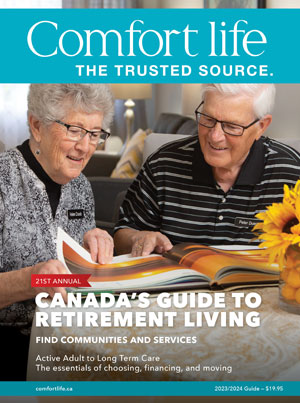“It’s like going to an all-inclusive resort,” says Kim Jimmo-Shields. She has been executive director of Abbeylawn Manor since it was founded nine years ago. “Its like a little country inn.”
Which is exactly how she’d like people to think of it. “I always say, call it a holiday. The door is open to go back if they want to. I just say, let us do our thing.”

At Abbeylawn, as elsewhere, short stays are an option for respite care or recuperative stays, often on the advice of a physician. But there are other options, too. Stephanie Hartwick is an administrator at Harbour Hill in Goderich, Ontario. She says that “If somebody wants to come just for the winter—say from December first to March first—you can do that. Or, if you’ve had a water leak in your house, and would like get away while its repaired, you can do that too.”
“We’re an option that is available to people,” adds Hartwick. “And yes, absolutely, people are so surprised—you know, they’ll say ‘You guys are really flexible!’”
Hartwick notes that there are lots of benefits of short stays, including a chance to get a sense of what it’s all about without having to make any big, long-term decisions. “The biggest challenge that we’re up against is that social vision of nursing homes. That the bars clang shut and nobody comes to see you anymore.”
Short stays can address those kinds of anxieties. “There are no doors closed behind them,” says Shields. As a result, “they are more open to becoming comfortable, because they still have a home to go back to.”
That said, many choose to stay. “What I see is some pretty frail people come in, and once they’re here for a few months you can see them thriving. It’s a whole new world for them. On admission they say, ‘Oh no I don’t do that,’ but then they realize that they just have to walk down the hall to a lounge, and they start opening up to the possibility.”
“There is still that fear, that hesitation,” she admits, though it typically fades quickly. “I get calls from daughters saying, ‘I’ve been calling mom and she’s not answering the phone,’” she says with a chuckle, “and I know full well that she’s at an activity. They learn they don’t need the daughter checking in as often.”
Rather than champing at the bit to go home, Jimmo-Shields finds that visitors typically leave wondering where all the time went. “There is a common comment that I always receive when people have stayed with us, and that’s ‘I don’t know why I waited so long.’ They enjoy the social aspect, the safety and security, and the pampering they get.”
How long should I stay? Of course, it varies from home to home, which can be a function of both availability and policy. That said, many homes are more flexible than you might think, with visitors able to stay as long, or as short, as they’d like to. Jimmo-Shields typically recommends that visitors consider staying at least two weeks. “Have you gone to an all inclusive?” —I say that I have—“Well it’s just like that. One week just isn’t enough. With one week they are just waiting to go home. They haven’t opened themselves to what we have to offer. I just don’t think it’s long enough.” The real value, she says, comes in the second week and beyond.
How do I book a stay? Recuperative stays are often made through a physician referral, though they certainly don’t have to be made that way. Best is just to call around to the homes in your area and ask. More often than not, you’ll be pleasantly surprised at how readily even very specific stay requests can be accommodated.
•
-Glen Herbert
Kim Jimmo-Shields is executive director of Abbeylawn Manor in Pickering, Ontario. Stephanie Hartwick is an administrator at Harbour Hill in Goderich, Ontario.




